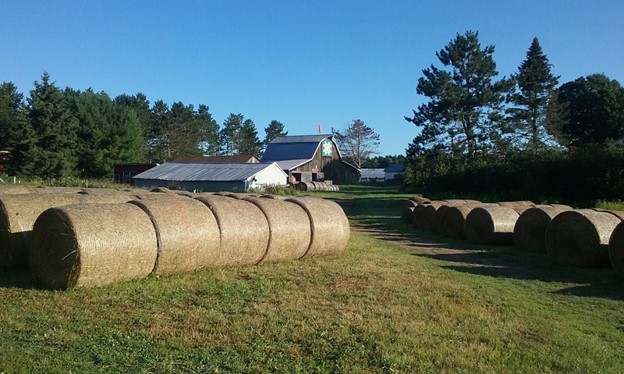Just Before the Storms

Sultry, hot summer stretches spell trouble on the homestead. Blue morning skies are swept over by growling storm clouds. So far this summer, our farm continues to be lucky as word of terrible damages remind us of what can happen under Mother Nature’s fury.
With all the rain, it’s been hard to find that dry gap for making first-crop hay. But we eventually went for it, with the Groeschls arriving with their large equipment on a Thursday morning. We used to cut our own hay, but the antiquated, always breaking down equipment kept turning the task into a nightmare, and our time was needed at Farmstead Creamery.
It was Sunday when it was baling time, and Kara was out with the skid steer, unloading the round bales from the hay wagon as Steve drove back and forth from field to yard where Kara lines them up in neat rows for storage. Storms were predicted that evening, as temps and humidity kept rising.
Mom and I were holding down Farmstead when the baler pulled into the service entrance and the crew drove off. What happened? Surely there was no way all the baling could have been finished yet? Was it broke down? I checked the radar, watching the line of green, yellow, and red marching across Minnesota.
But after near an hour he returned with more mesh wrapping for the bales, and off he went back to the field. Nearly 200 round bales later, all the equipment was tucked away just in time for the rains that lasted most of the night. If cut hay is rained on in the field, it starts to decompose, degrading its feed value and increasing moldiness of bales. Too much degradation, and the sheep will refuse to eat it—all that work spoilt and rotted. Wet bales can also grow so hot from anaerobic decomposition that they will spontaneously burst into flames! It’s a recipe for a barn fire no farmer wants to try.
So, the bales were safe, but Monday was equally atrociously hot. We had all kinds of garden work planned, but none of us could function. It was time to hit the lake and come back to work in the evening. We packed up and savored the air conditioning as we made our way to Moose Lake and Steve’s family’s old cabin.
I like to sit on the screened porch of the cabin and work on an art project while the rest of the crew is out fishing. I can listen to the sounds of the lake and just have some quiet personal time. They had the plug in the boat, Kara was wading in the lake, and Steve was nabbing the fishing poles when I asked if there was a fan I could use to help move the air on the porch. Steve found a nice big one, plugged it in, and a few seconds later is sputtered and stopped working. We tried turning on the lights and testing the breaker, but nothing came on—power outage.
Turned out the whole grid went down that day due to a tornado further south, so we hauled everything back into the car and came home because a power outage can create serious trouble in the aquaponics greenhouse as well as for the dairy equipment, which had already lost some key parts to power surges earlier in the week. Talk about disappointing!
So, there we were back on the farm again, putting things back in order, so we munched on a lunch-like snack and headed back out to the gardens as clouds covered the sky. Then they rumbled. Steve and I ran out to the chicken tractors and staked them down with T-posts and baling twine, then returned to the task of transplanting eggplants in the small high tunnel behind our house when it struck.
Steve was entirely drenched. The rain came down sideways, billowing into the high tunnel as we shoveled in compost and dug holes. Trees whipped. I was so grateful we had those lightweight tractors secured and that we were home and not out in the middle of the lake!
Several storms later, it was Friday. Heat index warnings had been flaring all day, along with the threat of severe weather into the afternoon. I was teaching a “gliding loon” needle felting class in Farmstead’s Fiber Loft to a group of eager students when the blaring weather alarm came on my phone. Great blobs of red on the radar were approaching. At first it looked like the initial wave might skirt north, but then it dipped downwards.
Leaving the experienced students to help the newer ones add eyes to their loons, I rushed out in my summer dress and crocks, grabbing the fence post puller and pounder. Mom and Steve dashed about the barnyard, closing windows and doors, hauling in the seedlings, nabbing anything that might blow about. Kara joined me in the field and lightning visibly flashes to the west. There’s nothing to get your heart rate up quite like pounding in a metal T-post in the middle of an open pasture with lightning!
We dashed back to the barnyard, and I literally ran back down the gravel lane to class as the first drops smacked against my shoulders. Rather out of breath and grateful that all the outdoor glass art had been brought in, I sent out a silent message of hope for the safety of our farm.
So far, we have been very fortunate to have had everything buttoned down just before the storms and to have made it through with mostly just electrical complications. Events like these illustrate how critical it is to keep an eye on the radar and stay responsive in the face of severe weather. I hope that you too have been able to stay safe in these summer storms! See you down on the farm sometime.






